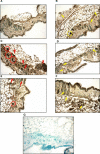An antivector vaccine protects against a lethal vector-borne pathogen
- PMID: 16604154
- PMCID: PMC1424664
- DOI: 10.1371/journal.ppat.0020027
An antivector vaccine protects against a lethal vector-borne pathogen
Abstract
Vaccines that target blood-feeding disease vectors, such as mosquitoes and ticks, have the potential to protect against the many diseases caused by vector-borne pathogens. We tested the ability of an anti-tick vaccine derived from a tick cement protein (64TRP) of Rhipicephalus appendiculatus to protect mice against tick-borne encephalitis virus (TBEV) transmitted by infected Ixodes ricinus ticks. The vaccine has a "dual action" in immunized animals: when infested with ticks, the inflammatory and immune responses first disrupt the skin feeding site, resulting in impaired blood feeding, and then specific anti-64TRP antibodies cross-react with midgut antigenic epitopes, causing rupture of the tick midgut and death of engorged ticks. Three parameters were measured: "transmission," number of uninfected nymphal ticks that became infected when cofeeding with an infected adult female tick; "support," number of mice supporting virus transmission from the infected tick to cofeeding uninfected nymphs; and "survival," number of mice that survived infection by tick bite and subsequent challenge by intraperitoneal inoculation of a lethal dose of TBEV. We show that one dose of the 64TRP vaccine protects mice against lethal challenge by infected ticks; control animals developed a fatal viral encephalitis. The protective effect of the 64TRP vaccine was comparable to that of a single dose of a commercial TBEV vaccine, while the transmission-blocking effect of 64TRP was better than that of the antiviral vaccine in reducing the number of animals supporting virus transmission. By contrast, the commercial antitick vaccine (TickGARD) that targets only the tick's midgut showed transmission-blocking activity but was not protective. The 64TRP vaccine demonstrates the potential to control vector-borne disease by interfering with pathogen transmission, apparently by mediating a local cutaneous inflammatory immune response at the tick-feeding site.
Conflict of interest statement
Figures



Similar articles
-
Importance of localized skin infection in tick-borne encephalitis virus transmission.Virology. 1996 May 15;219(2):357-66. doi: 10.1006/viro.1996.0261. Virology. 1996. PMID: 8638401
-
Immunization with recombinant subolesin does not reduce tick infection with tick-borne encephalitis virus nor protect mice against disease.Vaccine. 2013 Mar 15;31(12):1582-9. doi: 10.1016/j.vaccine.2013.01.017. Epub 2013 Jan 25. Vaccine. 2013. PMID: 23357197
-
Functional role of 64P, the candidate transmission-blocking vaccine antigen from the tick, Rhipicephalus appendiculatus.Int J Parasitol. 2009 Nov;39(13):1485-94. doi: 10.1016/j.ijpara.2009.05.005. Epub 2009 May 27. Int J Parasitol. 2009. PMID: 19481086
-
Non-viraemic transmission of tick-borne viruses.Acta Virol. 2013;57(2):123-9. doi: 10.4149/av_2013_02_123. Acta Virol. 2013. PMID: 23600870 Review.
-
Anti-tick and pathogen transmission blocking vaccines.Parasite Immunol. 2021 May;43(5):e12831. doi: 10.1111/pim.12831. Epub 2021 Mar 18. Parasite Immunol. 2021. PMID: 33704804 Review.
Cited by
-
Oral vaccination with vaccinia virus expressing the tick antigen subolesin inhibits tick feeding and transmission of Borrelia burgdorferi.Vaccine. 2012 Sep 14;30(42):6040-6. doi: 10.1016/j.vaccine.2012.07.053. Epub 2012 Aug 2. Vaccine. 2012. PMID: 22864146 Free PMC article.
-
Induction of humoral immune response to multiple recombinant Rhipicephalus appendiculatus antigens and their effect on tick feeding success and pathogen transmission.Parasit Vectors. 2016 Sep 2;9(1):484. doi: 10.1186/s13071-016-1774-0. Parasit Vectors. 2016. PMID: 27589998 Free PMC article.
-
Immunity against Ixodes scapularis salivary proteins expressed within 24 hours of attachment thwarts tick feeding and impairs Borrelia transmission.PLoS One. 2007 May 16;2(5):e451. doi: 10.1371/journal.pone.0000451. PLoS One. 2007. PMID: 17505544 Free PMC article.
-
Counterattacking the tick bite: towards a rational design of anti-tick vaccines targeting pathogen transmission.Parasit Vectors. 2019 May 14;12(1):229. doi: 10.1186/s13071-019-3468-x. Parasit Vectors. 2019. PMID: 31088506 Free PMC article. Review.
-
Flipping the paradigm on malaria transmission-blocking vaccines.Trends Parasitol. 2008 Aug;24(8):364-70. doi: 10.1016/j.pt.2008.05.002. Epub 2008 Jul 1. Trends Parasitol. 2008. PMID: 18599352 Free PMC article. Review.
References
-
- Bell JF, Stewart J, Wikel SK. Resistance to tickborne Francisella tularensis by tick-sensitized rabbits: Allergic kendusity. Am J Trop Med Hyg. 1979;28:876–880. - PubMed
-
- Francis J, Little DA. Resistance of Droughtmaster cattle to tick infestation and babesiosis. Aust Vet J. 1964;40:247–253.
-
- Jones LD, Nuttall PA. The effect of host resistance to tick infestation on the transmission of Thogoto virus by ticks. J Gen Virol. 1990;71:1039–1043. - PubMed
-
- Mishaeva NP. The protection of vertebrate animals from experimental tick-borne encephalitis with active and passive immunization against tick antigens. Zh Mikrobiol Epidemiol Immunobiol. 1990;8:93–98. - PubMed
Publication types
MeSH terms
Substances
Associated data
- Actions
LinkOut - more resources
Full Text Sources
Other Literature Sources
Medical

